The Warming Effect of Urbanization in the Urban Agglomeration Area Accelerates Vegetation Growth on the Urban–Rural Gradient
Abstract
:1. Introduction
2. Materials and Methods
2.1. Study Area
2.2. Data Sources
- (1)
- MODIS-LST. The widely-used MOD11A2 V6 product provides a time series of 8-day average land surface temperature (LST) with a 1-kilometer spatial resolution with a high accuracy [34,35]. In this study, the daytime surface temperatures of “LST_Day_1 km” were used to represent the LST, and the maximum-value composite data processing was transcribed into monthly data on the Google Earth Engine (GEE). Next, the brightness values (DN) was converted to degrees (°C). The quality of the data was also assessed by the ground-weather-station records. Using the average atmospheric temperature records of 7 stations in the study area, we analyzed the temperature records of the stations corresponding to MODIS-LST, and established a univariate linear regression analysis. The results showed that at the significant p < 0.01 level, the slope coefficient was in the range of 0.87~1.11, and the determination R2 was 0.72–0.79, indicating that the MODIS-LST data reflected the real thermal environment in the study area.
- (2)
- MODIS-NDVI. The MODIS-NDVI dataset covered the period from 2001 to 2020, with a spatial resolution of 250 m and a temporal resolution of 16 days. The maximum monthly data processing was completed on the GEE platform.
- (3)
- Impervious Surface Data. The land use/land-cover data were mapped by random forest method on the Google Earth Engine (GEE) platform from 2000 to 2020 [36]. Land-cover types were divided into six categories: cultivated land, forest land, grassland, water area, impervious surface, and unused land. The accuracy of various land-cover categories was above 88%. Next, the percentage of impervious surface area (ISP) for every 5 years was calculated on a grid with a size of 250 m × 250 m. The ISP represented a dynamic urban–rural gradient from 0% to 100%.
- (4)
- Auxiliary data. The vegetation-type data were obtained from the National Glacier and Permafrost Desert Science Data Center. The vegetation-type data from the study area were extracted to estimate NPP. The climatic data, including the monthly sunshine percentage, monthly average temperature, and monthly precipitation data of 26 meteorological stations in the study area, were downloaded from the China Meteorological Science Data Sharing Service Network (http://cdc.cma.gov.cn/, accessed on 3 March 2021), which were interpolated in a spatial resolution of 250 m and used for NPP estimation [37,38].
2.3. Methods
2.3.1. Estimated NPP
2.3.2. ISP vs. LST
2.3.3. Identifying Indirect Urbanization Effects on Vegetation Growth
2.3.4. Quantifying the Effects of Warming on Vegetation Growth
3. Results
3.1. The Urbaniztion-Induced Thermal Environment Changes
3.2. Indirect Impact of Urbanization on NPP
3.3. The Impact of Thermal Environment Changes on NPP
3.4. Warming-Induced Effects on Vegetation Growth
4. Discussion
4.1. Land-Surface-Warming Imprint on NPP Change
4.2. Uncertainty and Limitations
5. Conclusions
Author Contributions
Funding
Data Availability Statement
Conflicts of Interest
References
- Liu, X.; Huang, Y.; Xu, X.; Li, X.; Li, X.; Ciais, P.; Lin, P.; Gong, K.; Ziegler, A.D.; Chen, A.; et al. High-spatiotemporal-resolution mapping of global urban change from 1985 to 2015. Nat. Sustain. 2020, 3, 564–570. [Google Scholar] [CrossRef]
- Chen, M.; Liu, W.; Lu, D. Challenges and the way forward in China’s new-type urbanization. Land Use Policy 2016, 55, 334–339. [Google Scholar] [CrossRef]
- Chen, G.; Li, X.; Liu, X.; Chen, Y.; Liang, X.; Leng, J.; Xu, X.; Liao, W.; Qiu, Y.A.; Wu, Q.; et al. Global projections of future urban land expansion under shared socioeconomic pathways. Nat. Commun. 2020, 11, 537. [Google Scholar] [CrossRef] [PubMed] [Green Version]
- Pickett, S.T.A.; Cadenasso, M.L.; Grove, J.M.; Boone, C.G.; Groffman, P.M.; Irwin, E.; Kaushal, S.S.; Marshall, V.; McGrath, B.P.; Nilon, C.H.; et al. Urban ecological systems: Scientific foundations and a decade of progress. J. Environ. Manag. 2011, 92, 331–362. [Google Scholar] [CrossRef] [PubMed]
- Youngsteadt, E.; Dale, A.G.; Terando, A.J.; Dunn, R.R.; Frank, S.D. Do cities simulate climate change? A comparison of herbivore response to urban and global warming. Global Chang. Biol. 2015, 21, 97–105. [Google Scholar] [CrossRef]
- Zhao, S.; Zhou, D.; Zhu, C.; Qu, W.; Zhao, J.; Sun, Y.; Huang, D.; Wu, W.; Liu, S. Rates and patterns of urban expansion in China’s 32 major cities over the past three decades. Landsc. Ecol. 2015, 30, 1541–1559. [Google Scholar] [CrossRef]
- Paolini, L.; Aráoz, E.; Gioia, A.; Powell, P.A. Vegetation productivity trends in response to urban dynamics. Urban For. Urban Green. 2016, 17, 211–216. [Google Scholar] [CrossRef]
- Haberl, H.; Erb, K.H.; Krausmann, F.; Gaube, V.; Bondeau, A.; Plutzar, C.; Gingrich, S.; Lucht, W.; Fischer-Kowalski, M. Quantifying and mapping the human appropriation of net primary production in earth’s terrestrial ecosystems. Proc. Natl. Acad. Sci. USA 2007, 104, 12942–12947. [Google Scholar] [CrossRef] [Green Version]
- Martínez, B.; Sánchez-Ruiz, S.; Campos-Taberner, M.; García-Haro, F.J.; Gilabert, M.A. Exploring Ecosystem Functioning in Spain with Gross and Net Primary Production Time Series. Remote Sens. 2022, 14, 1310. [Google Scholar] [CrossRef]
- Liu, X.; Pei, F.; Wen, Y.; Li, X.; Wang, S.; Wu, C.; Cai, Y.; Wu, J.; Chen, J.; Feng, K.; et al. Global urban expansion offsets climate-driven increases in terrestrial net primary productivity. Nat. Commun. 2019, 10, 5558. [Google Scholar] [CrossRef] [Green Version]
- Roy, S.; Byrne, J.; Pickering, C. A systematic quantitative review of urban tree benefits, costs, and assessment methods across cities in different climatic zones. Urban For. Urban Green. 2012, 11, 351–363. [Google Scholar] [CrossRef] [Green Version]
- Chen, W.Y. The role of urban green infrastructure in offsetting carbon emissions in 35 major Chinese cities: A nationwide estimate. Cities 2015, 44, 112–120. [Google Scholar] [CrossRef]
- Griscom, B.W.; Adams, J.; Ellis, P.W.; Houghton, R.A.; Lomax, G.; Miteva, D.A.; Schlesinger, W.H.; Shoch, D.; Siikamäki, J.V.; Smith, P.; et al. Natural climate solutions. Proc. Natl. Acad. Sci. USA 2017, 114, 11645–11650. [Google Scholar] [CrossRef] [PubMed] [Green Version]
- Grimm, N.B.; Faeth, S.H.; Golubiewski, N.E.; Redman, C.L.; Wu, J.; Bai, X.; Briggs, J.M. Global Change and the Ecology of Cities. Science 2008, 319, 756–760. [Google Scholar] [CrossRef] [PubMed] [Green Version]
- Zhao, S.; Liu, S.; Zhou, D. Prevalent vegetation growth enhancement in urban environment. Proc. Natl. Acad. Sci. USA 2016, 113, 6313–6318. [Google Scholar] [CrossRef] [Green Version]
- Chen, Y.; Huang, B.; Zeng, H. How does urbanization affect vegetation productivity in the coastal cities of eastern China? Sci. Total Environ. 2022, 811, 152356. [Google Scholar] [CrossRef]
- Zhong, J.; Liu, J.; Jiao, L.; Lian, X.; Xu, Z.; Zhou, Z. Assessing the comprehensive impacts of different urbanization process on vegetation net primary productivity in Wuhan, China, from 1990 to 2020. Sustain. Cities Soc. 2021, 75, 103295. [Google Scholar] [CrossRef]
- Liu, X.; Wang, P.; Song, H.; Zeng, X. Determinants of net primary productivity: Low-carbon development from the perspective of carbon sequestration. Technol. Forecast. Soc. Chang. 2021, 172, 121006. [Google Scholar] [CrossRef]
- Chen, Y.; Wang, J.; Xiong, N.; Sun, L.; Xu, J. Impacts of Land Use Changes on Net Primary Productivity in Urban Agglomerations under Multi-Scenarios Simulation. Remote Sens. 2022, 14, 1755. [Google Scholar] [CrossRef]
- Takagi, M.; Gyokusen, K. Light and atmospheric pollution affect photosynthesis of street trees in urban environments. Urban For. Urban Green. 2004, 2, 167–171. [Google Scholar] [CrossRef]
- Quigley, M.F. Street trees and rural conspecifics: Will long-lived trees reach full size in urban conditions? Urban Ecosyst. 2004, 7, 29–39. [Google Scholar] [CrossRef]
- Arnfield, A.J. Two decades of urban climate research: A review of turbulence, exchanges of energy and water, and the urban heat island. Int. J. Climatol. J. R. Meteorol. Soc. 2003, 23, 1–26. [Google Scholar] [CrossRef]
- Guan, X.; Shen, H.; Li, X.; Gan, W.; Zhang, L. A long-term and comprehensive assessment of the urbanization-induced impacts on vegetation net primary productivity. Sci. Total Environ. 2019, 669, 342–352. [Google Scholar] [CrossRef] [PubMed]
- Jónsson, S.; Segall, P.; Pedersen, R.; Björnsson, G. Post-earthquake ground movements correlated to pore-pressure transients. Nature 2003, 424, 179–183. [Google Scholar] [CrossRef]
- Ziska, L.H.; Bunce, J.A.; Goins, E.W. Characterization of an Urban-Rural CO2/Temperature Gradient and Associated Changes in Initial Plant Productivity during Secondary Succession. Oecologia 2004, 139, 454–458. [Google Scholar] [CrossRef]
- Wu, S.; Zhou, S.; Chen, D.; Wei, Z.; Dai, L.; Li, X. Determining the contributions of urbanisation and climate change to NPP variations over the last decade in the Yangtze River Delta, China. Sci. Total Environ. 2014, 472, 397–406. [Google Scholar] [CrossRef]
- Yan, Y.; Wu, C.; Wen, Y. Determining the impacts of climate change and urban expansion on net primary productivity using the spatio-temporal fusion of remote sensing data. Ecol. Indic. 2021, 127, 107737. [Google Scholar] [CrossRef]
- Zhong, Q.; Ma, J.; Zhao, B.; Wang, X.; Zong, J.; Xiao, X. Assessing spatial-temporal dynamics of urban expansion, vegetation greenness and photosynthesis in megacity Shanghai, China during 2000–2016. Remote Sens. Environ. 2019, 233, 111374. [Google Scholar] [CrossRef]
- Wei, S.; Chen, Q.; Wu, W.; Ma, J. Quantifying the indirect effects of urbanization on urban vegetation carbon uptake in the megacity of Shanghai, China. Environ. Res. Lett. 2021, 16, 64088. [Google Scholar] [CrossRef]
- Zhao, L.; Lee, X.; Smith, R.B.; Oleson, K. Strong contributions of local background climate to urban heat islands. Nature 2014, 511, 216–219. [Google Scholar] [CrossRef]
- Wang, J.; Xiang, Z.; Wang, W.; Chang, W.; Wang, Y. Impacts of strengthened warming by urban heat island on carbon sequestration of urban ecosystems in a subtropical city of China. Urban Ecosyst. 2021, 24, 1165–1177. [Google Scholar] [CrossRef]
- Wang, S.; Ju, W.; Peñuelas, J.; Cescatti, A.; Zhou, Y.; Fu, Y.; Huete, A.; Liu, M.; Zhang, Y. Urban−rural gradients reveal joint control of elevated CO2 and temperature on extended photosynthetic seasons. Nat. Ecol. Evol. 2019, 3, 1076–1085. [Google Scholar] [CrossRef] [PubMed] [Green Version]
- Lu, Y.; Yang, J.; Peng, M.; Li, T.; Wen, D.; Huang, X. Monitoring ecosystem services in the Guangdong-Hong Kong-Macao Greater Bay Area based on multi-temporal deep learning. Sci. Total Environ. 2022, 822, 153662. [Google Scholar] [CrossRef] [PubMed]
- Kuang, W.; Liu, Y.; Dou, Y.; Chi, W.; Chen, G.; Gao, C.; Yang, T.; Liu, J.; Zhang, R. What are hot and what are not in an urban landscape: Quantifying and explaining the land surface temperature pattern in Beijing, China. Landsc. Ecol. 2015, 30, 357–373. [Google Scholar] [CrossRef]
- Ma, Q.; Wu, J.; He, C. A hierarchical analysis of the relationship between urban impervious surfaces and land surface temperatures: Spatial scale dependence, temporal variations, and bioclimatic modulation. Landsc. Ecol. 2016, 31, 1139–1153. [Google Scholar] [CrossRef]
- Dubeau, P.; King, D.; Unbushe, D.; Rebelo, L. Mapping the Dabus Wetlands, Ethiopia, Using Random Forest Classification of Landsat, PALSAR and Topographic Data. Remote Sens. 2017, 9, 1056. [Google Scholar] [CrossRef] [Green Version]
- Du, Y.; Mao, H.; Liu, A.; Pan, W. The climatological calculation and distribution of global solar radiation in Guangdong Province. Res. Sci. 2003, 25, 66–70. (In Chinese) [Google Scholar]
- Vicente-Serrano, S.M.; Saz-Sánchez, M.A.; Cuadrat, J.M. Comparative analysis of interpolation methods in the middle Ebro Valley (Spain): Application to annual precipitation and temperature. Clim. Res. 2003, 24, 161–180. [Google Scholar] [CrossRef] [Green Version]
- Zhu, W.; Pan, Y.; Zhang, J. Estimation of net primary productivity of Chinese terrestrial vegetation based on remote sensing. Chin. J. Plant Ecol. 2007, 31, 413–424. (In Chinese) [Google Scholar]
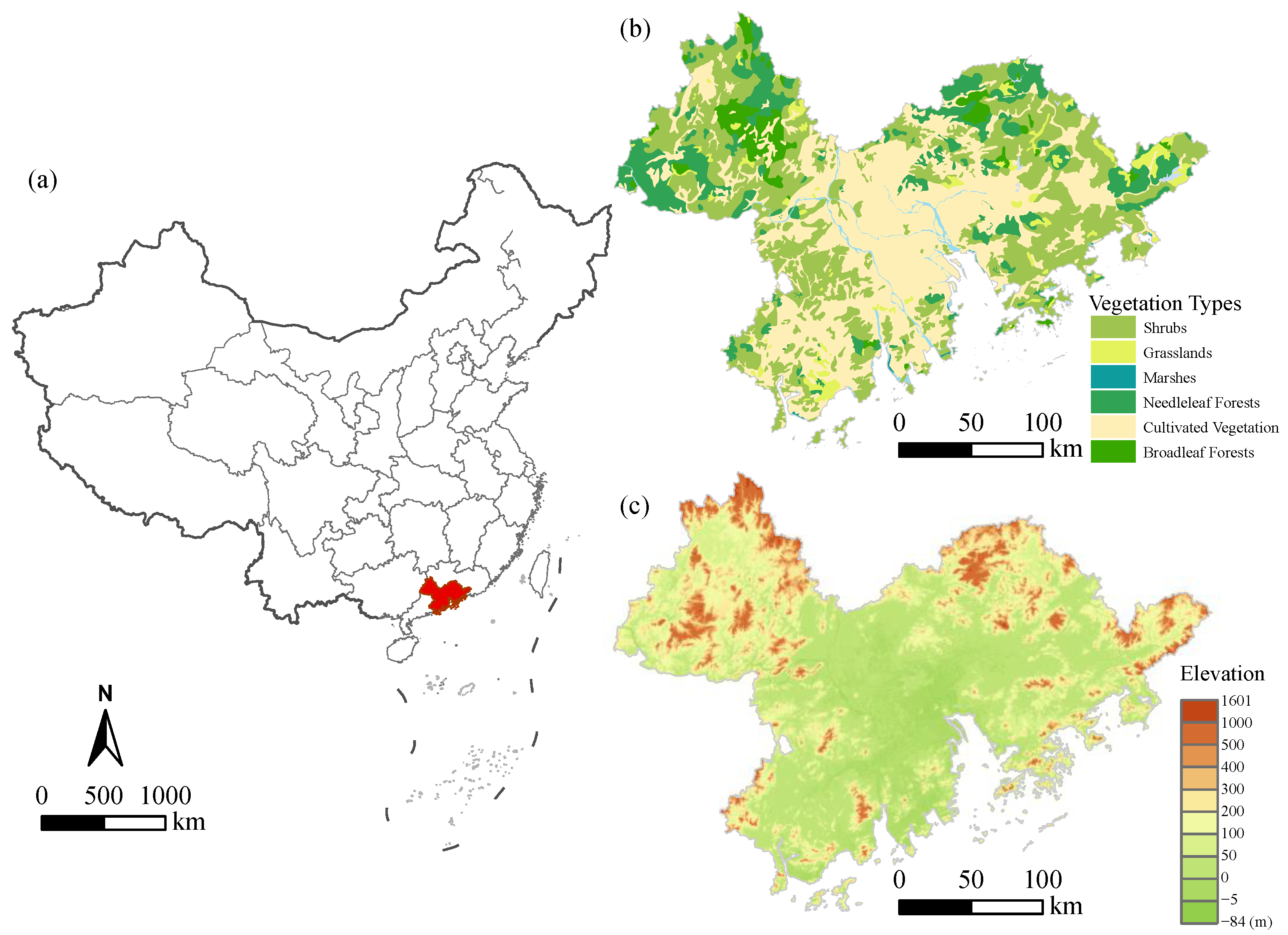
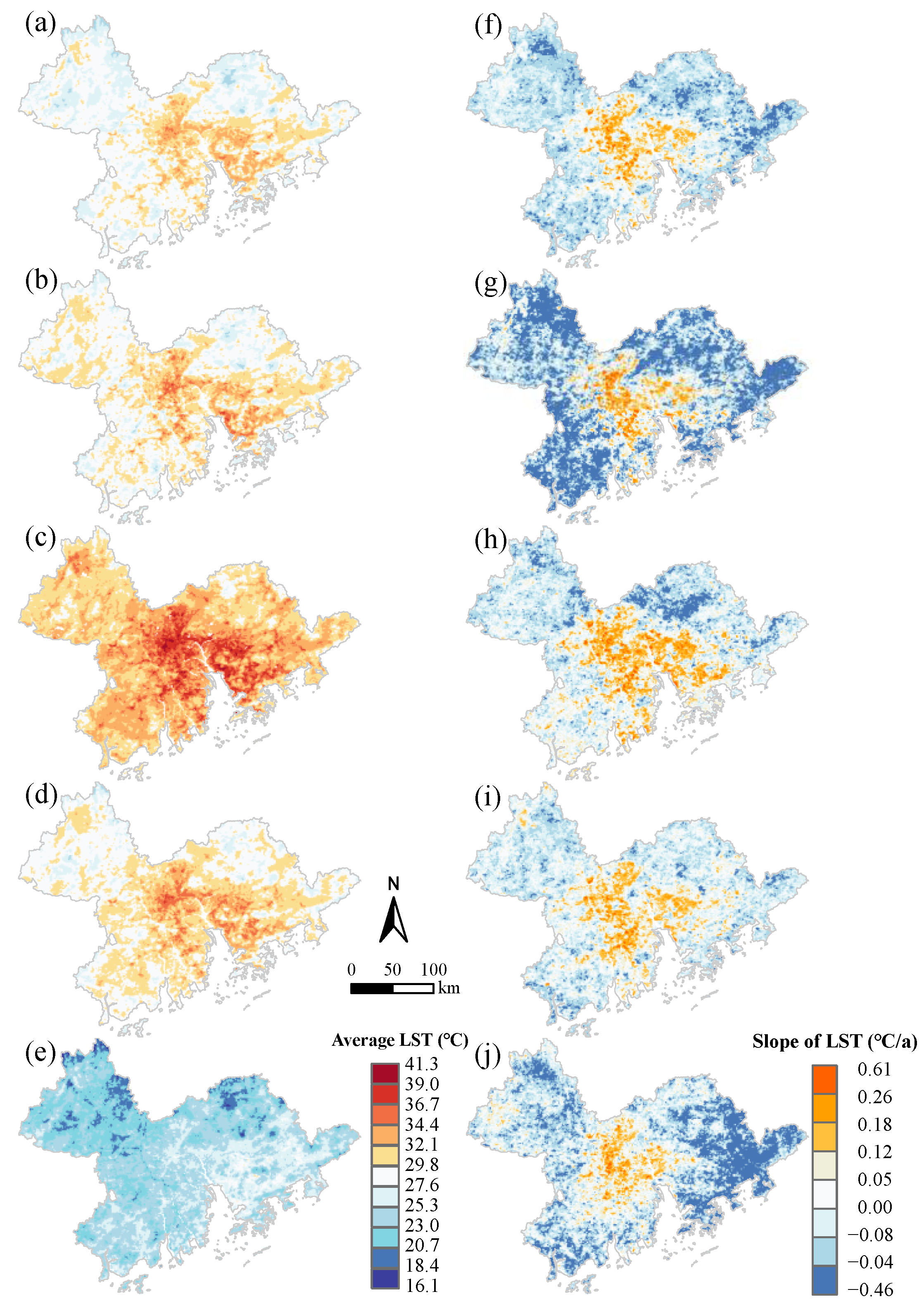
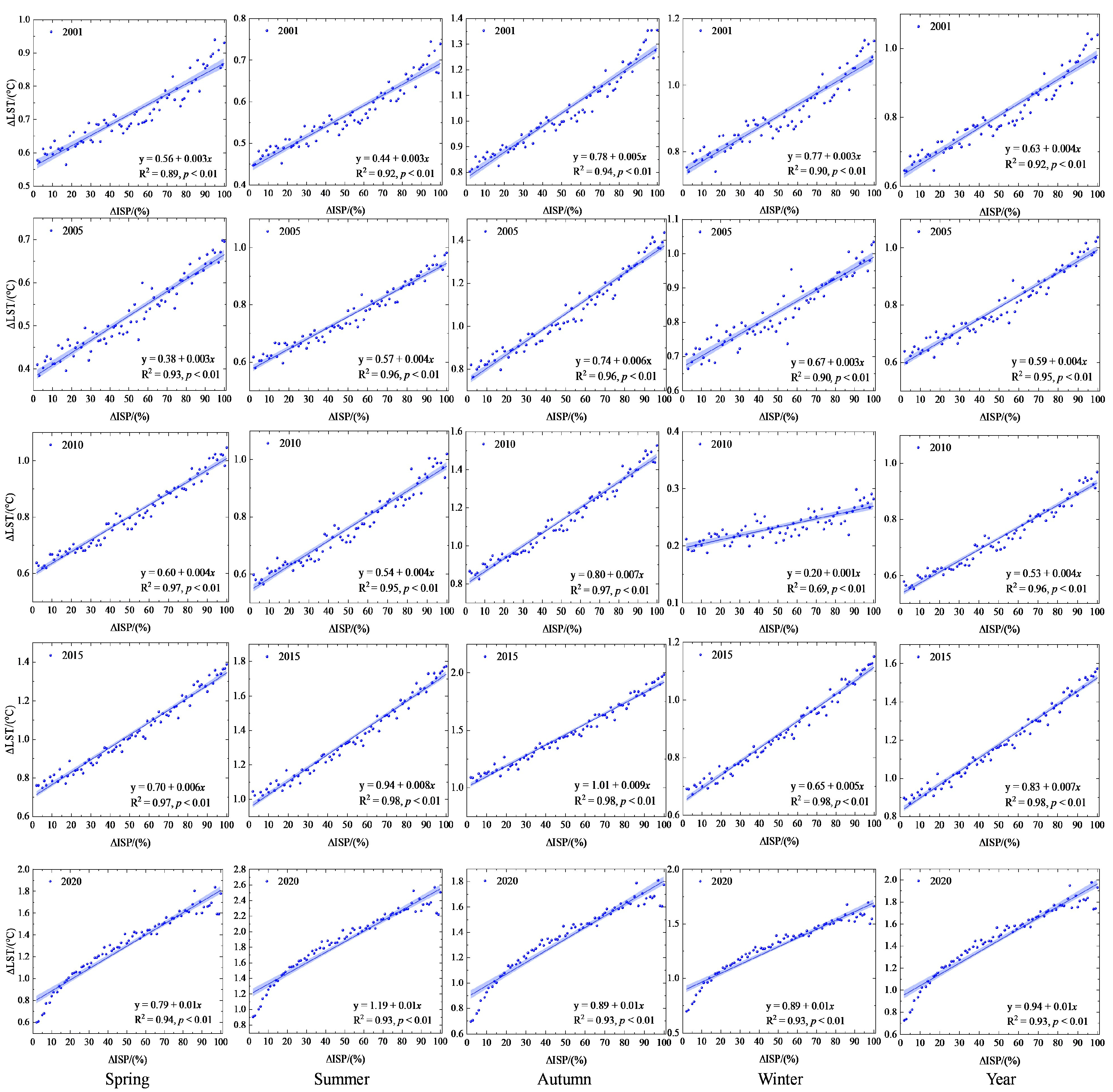
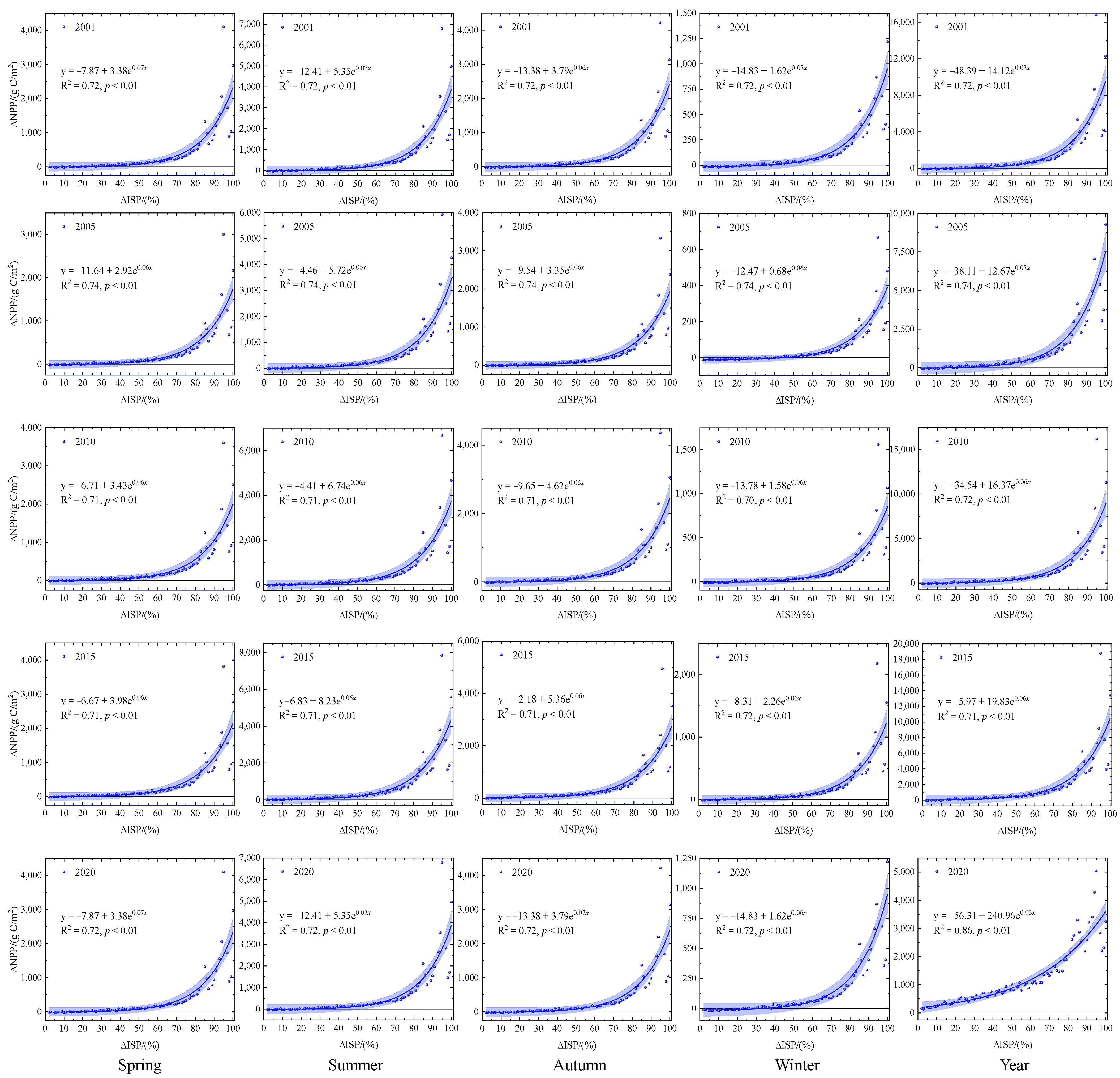

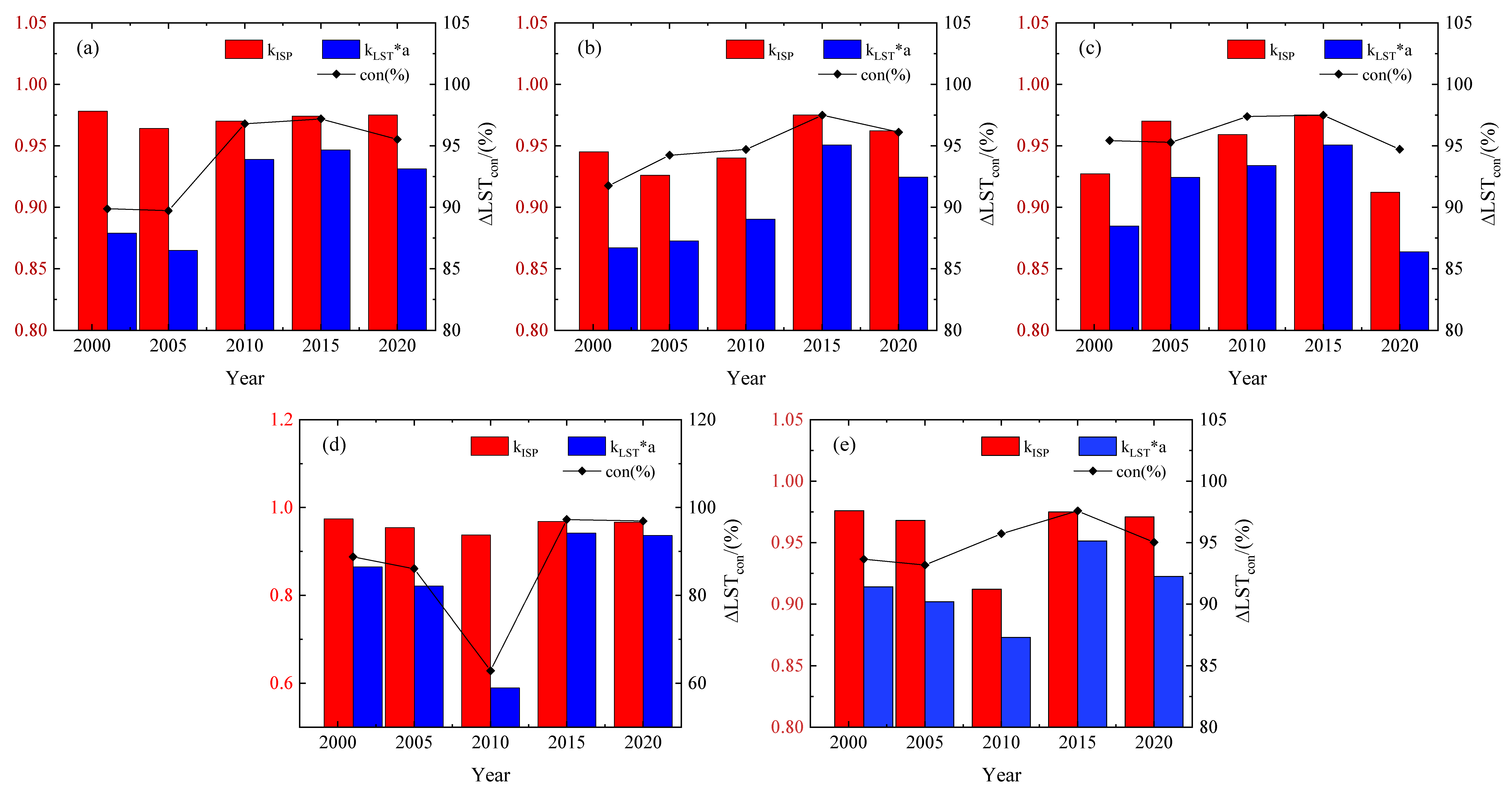
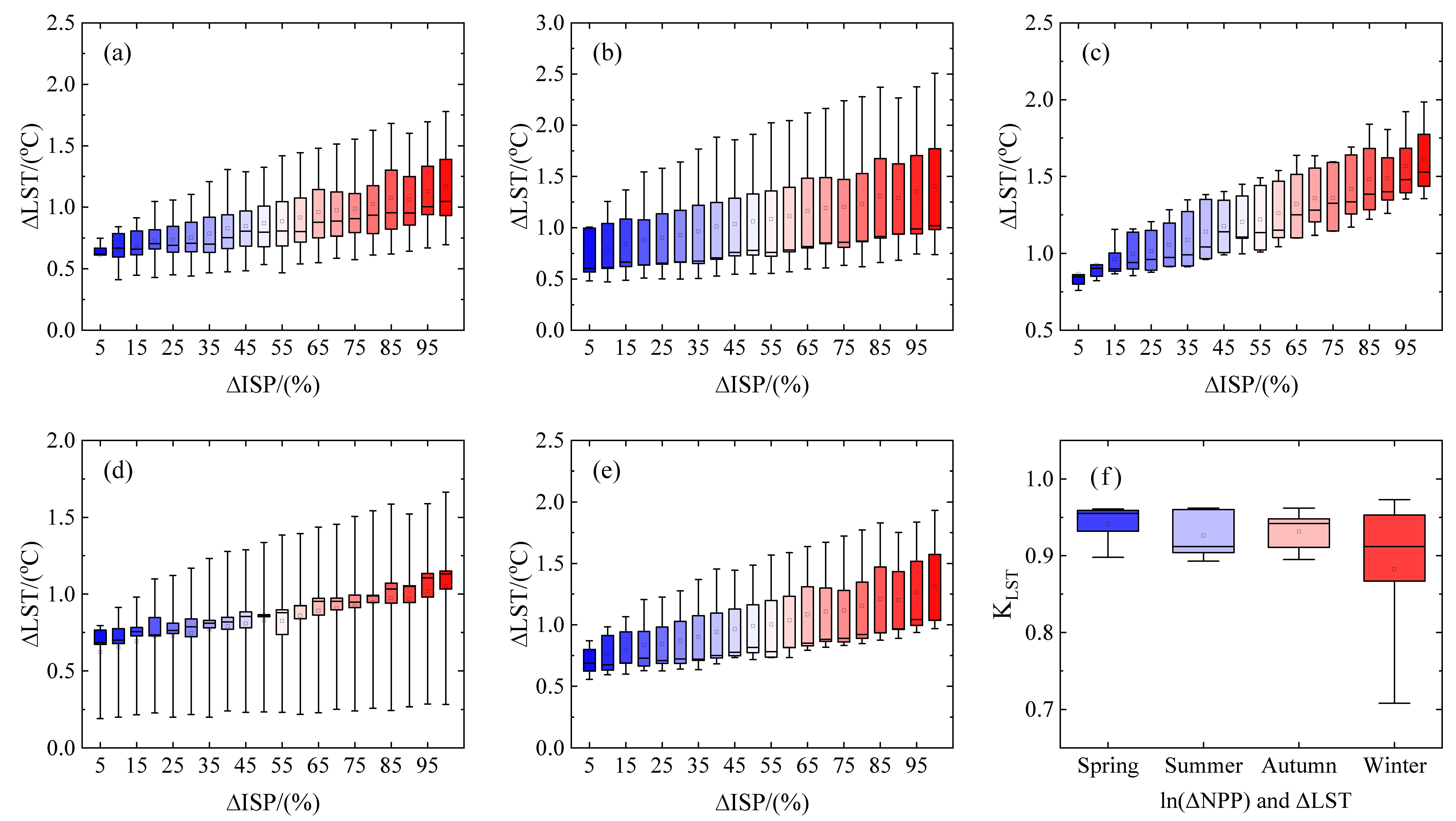
Publisher’s Note: MDPI stays neutral with regard to jurisdictional claims in published maps and institutional affiliations. |
© 2022 by the authors. Licensee MDPI, Basel, Switzerland. This article is an open access article distributed under the terms and conditions of the Creative Commons Attribution (CC BY) license (https://creativecommons.org/licenses/by/4.0/).
Share and Cite
Feng, Z.; Liu, Z.; Zhou, Y. The Warming Effect of Urbanization in the Urban Agglomeration Area Accelerates Vegetation Growth on the Urban–Rural Gradient. Remote Sens. 2022, 14, 2869. https://doi.org/10.3390/rs14122869
Feng Z, Liu Z, Zhou Y. The Warming Effect of Urbanization in the Urban Agglomeration Area Accelerates Vegetation Growth on the Urban–Rural Gradient. Remote Sensing. 2022; 14(12):2869. https://doi.org/10.3390/rs14122869
Chicago/Turabian StyleFeng, Zhitao, Zhenhuan Liu, and Yi Zhou. 2022. "The Warming Effect of Urbanization in the Urban Agglomeration Area Accelerates Vegetation Growth on the Urban–Rural Gradient" Remote Sensing 14, no. 12: 2869. https://doi.org/10.3390/rs14122869
APA StyleFeng, Z., Liu, Z., & Zhou, Y. (2022). The Warming Effect of Urbanization in the Urban Agglomeration Area Accelerates Vegetation Growth on the Urban–Rural Gradient. Remote Sensing, 14(12), 2869. https://doi.org/10.3390/rs14122869






